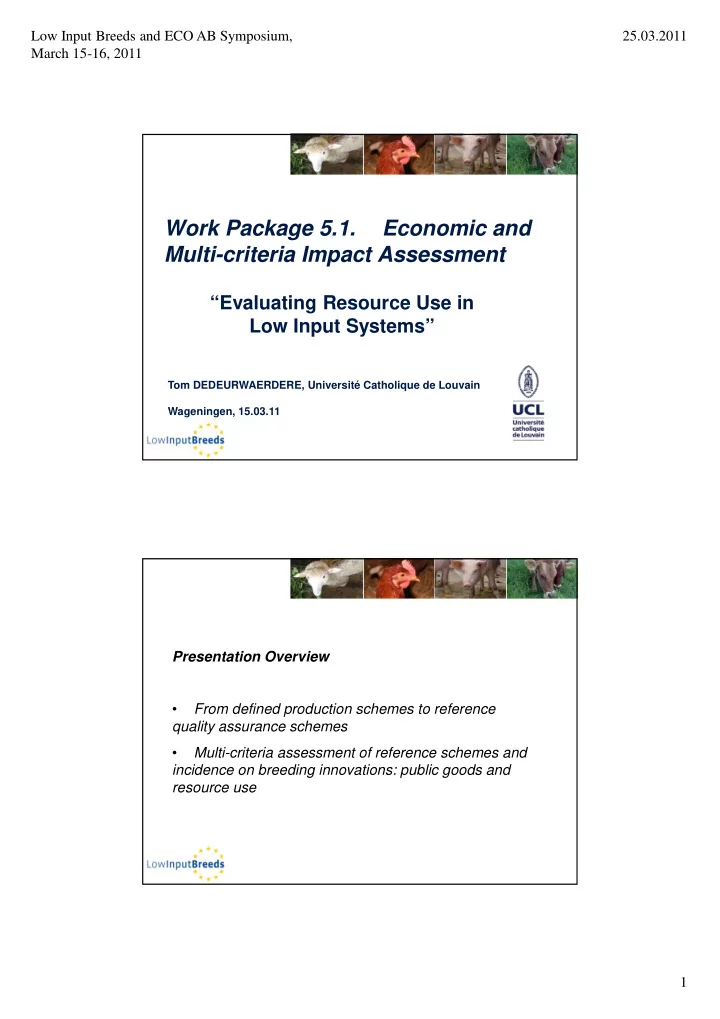

Low Input Breeds and ECO AB Symposium, 25.03.2011 March 15-16, 2011 Work Package 5.1. Economic and Multi-criteria Impact Assessment “Evaluating Resource Use in Low Input Systems” Tom DEDEURWAERDERE, Université Catholique de Louvain Wageningen, 15.03.11 Presentation Overview • From defined production schemes to reference quality assurance schemes • Multi-criteria assessment of reference schemes and incidence on breeding innovations: public goods and resource use 1
Low Input Breeds and ECO AB Symposium, 25.03.2011 March 15-16, 2011 1. Production Schemes identified in LIB project document • Dairy Cows (p. 39) • Certified organic dairy production systems which follow EU-organic farming standards • Non-organic ‘low input’ systems are either (a) traditional grazing based systems (often located in mountainous areas of Europe) (b) novel New Zealand-type low input/low cost systems (developed in some European regions due to decreasing milk prices and increasing input costs) Sheep (p. 79) • • Organically certified • Traditional (:extensively outdoor reared) • Pigs (p. 110-111) • Non-organic ‘low input’ systems usually characterised: • by smaller herd size, more space per animal, lower capital investment, often outdoor management, provision of bedding, greater labor requirement and focus on animal welfare. • Organic production systems have similar characteristics but with additional prescriptions as to stocking densities and access to outdoor runs, levels of ‘bought in, non-organic’ feeds and use of GM-feeds. • Laying Hens (p. 141) • Organically certified: (a) maximum / minimum outdoor husbandry, (b) using molting systems • Non-organic free-range 2
Low Input Breeds and ECO AB Symposium, 25.03.2011 March 15-16, 2011 2. Representative Sub-set Reference Schemes • Task 1 Working Package : • “Identification of a representative set of quality assurance reference schemes for the evaluation of livestock production systems under the LIB project” • Criteria for workable set of production systems? • Broad coverage of issues regarding animal welfare, pesticide use, climate change (forage), human health (antibiotics) • Identification of the systems we do want to evaluate and improve upon within the LIB project? • How? • Drawing from the definitions of production schemes in LIB project • Stakeholder consultation: Workshop in Brussels, 26.05.11 DAIRY COWS - Reference Schemes �� ����������� ��������������������������� �������� ����������������������������������� � ���������������������������������������� ���������� ���������������������������������������� �� 6 3
Low Input Breeds and ECO AB Symposium, 25.03.2011 March 15-16, 2011 SHEEP- Reference Schemes �� ������ ����������������������������� ����������� �������� !�������"���""������������������� !�������"���""���������������� ����������������������������� ����������� ���������� �������������������#�"�������������������������������������� ����������������#��$%���$� � ����&�������'���$������ � 7 PIGS - Reference Schemes �� ����� �������&���������#���������(�������)��*�������"������� ������������������#���������(�������)��*���������������"���������� �������� ��������$�������������������#�������������� ������������������#���������(�������)��*������������������������$������� ������������#�������������� ������������+������'����������������,�� ���'���������(����������#�����������������#��*�������"����������������-� ���������� *����������������� ���'���������(����������#�����������������#��*�������"�������������������� ���$�������-�*���������������� � 8 4
Low Input Breeds and ECO AB Symposium, 25.03.2011 March 15-16, 2011 LAYING HENS - Reference Schemes �� ������������ ��������(�������)��*������ �������"���.�/�0�12,333�� �������� ��������(�������)��*�������������"���.�/�0�4,333�� 5��#�+������������������������$����133��,����������#��������� � !����6��������#���������(�������)��*������ � ���������� !����6��������#���������(�������)��*������� !����6�����5��#�+���������������������� 9 3. Multi- Criteria Assessment Template Why an assessment? • Cost-benefit analysis of LI and Organic production • Price premium for various labelling and consumer information systems (e.g. organic label for animals, organic plus labels for others) • Subsidies for certain social welfare outputs of the production systems (e.g. for landscape preservation) Model to calculate the profit margins under the various production • systems and price premium scenarios • Assessment profit margins generated by improved breeds of LIB project 5
Low Input Breeds and ECO AB Symposium, 25.03.2011 March 15-16, 2011 Why an assessment? • Cost-benefit analysis of LI and Organic production • Assessment of profit margins generated by improved breeds resulting LIB project • Identify cases of improved organic or low input breeds for which there is evidence of both economic and societal benefits • Define measures to support rapid introduction of innovation in commercial practice Assessment Template Multi-Criteria Assessment Table • Criteria drawn from literature and legislation review • Consolidated through stakeholder consultation February - March 2010 ���#����+��������� ���*���7�������+�������� !����8��� ����� ��!!������ �"��������!!������ ���*�����9�����������$�������� !����������8��� ������������� �������$��$�����'����� 5�������������9������� #��$�%��&�� ���$����$&����� ���&��%����� �����������������#���� �����������$������ ($�������$������� �����������$��#�*����� :��$��'��*������� ���+�,���,!��� �����������*�������������������� 7�������$��'������ ���'���( ;������������������������������� �����������)*����� ����������������� ��-,������,�. �����������#����� :���*�����&6���������<�"����������6�:� ����������������/����.���� '��$�)��,�� �������������'�������/��������� ������ 6
Recommend
More recommend